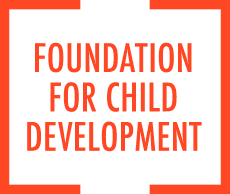Table of Contents
- Getting it Right Summer Webinar Series
- Getting it Right Summary
- Full Publication
- Section 1. What does research tell us about effectiveness and implementation of ECE programs across the birth-to-eight continuum?
- Section 2. What still needs to be understood?
- Section 3. How do we get smarter? The road forward
https://www.fcd-us.org/getting-it-right-using-implementation-research-to-improve-outcomes-in-early-care-and-education/
The Foundation for Child Development is proud to present its new publication, Getting it Right: Using Implementation Research to Improve Outcomes in Early Care and Education. The publication provides insights into the value of including implementation research in the study of early care and education (ECE) interventions and its potential to improve programs and policies and achieve stronger outcomes for all young children.
- Read the full publication
- Read the Getting it Right Summary
- Read Getting it Right: The Conversation Guide for Preparing the Next Generation of Implementation Researchers
- Read Getting it Right: The Conversation Guide for Preparing the Next Generation of ECE Practitioners
Now is the moment for ECE researchers and policymakers to identify the critical components of effective ECE programs and policies and to engage in meaningful exploration of what works, for whom, and under what conditions. Issues of race/ethnicity, socioeconomic status, cultural/linguistic background, immigration status, and gender must be explicitly investigated in the context of program implementation. As more programs are brought to scale, our ability to achieve greater impacts for all young children rests on a more nuanced understanding of how ECE programs and policies are being implemented locally and the differential impacts on specific subgroups of children.
This publication brings together the perspectives of prominent ECE researchers and attempts to answer three key questions for the field: What does research tell us about the effectiveness and implementation of ECE programs across the birth to 8 continuum? What still needs to be understood? How do we get smarter in designing future research directions and approaches?
The authors also discuss how research, particularly implementation research, can equip policymakers and practitioners with a deeper understanding of program implementation to support continuous quality improvement efforts. In addition, the authors examine implementation research approaches and methods and offer guidance about how to conduct such research and on what questions and topics to address for improving policy and practice.
It is time for the ECE field -- researchers, policymakers, and practitioners – to get it right by using implementation research to understand what it takes to strengthen outcomes for all young children.
Getting it Right Summer Webinar Series
Watch the three-part Getting it Right 2020 Summer Webinar Series on demand.
LEARN MORE
Getting it Right Summary
Access chapter summaries of Getting it Right: Using Implementation Research to Improve Outcomes in Early Care and Education here. This resource is intended to highlight key takeaways from the publication to further engage policymakers, practitioners, and researchers in meaningful exploration of what works, for whom, and under what conditions to improve programs and policies and achieve stronger outcomes for all young children.
Full Publication
Access an individual chapter and/or an individual section of Getting it Right: Using Implementation Research to Improve Outcomes in Early Care and Education.
Introduction: Implementation Research in Early Care and Education
By Jacqueline Jones, Ph.D., Foundation for Child Development
Section 1. What does research tell us about effectiveness and implementation of ECE programs across the birth-to-eight continuum?
Chapter 1: What Does Research Tell Us About ECE Programs?
By Margaret R. Burchinal, Ph.D., University of North Carolina at Chapel Hill and Dale C. Farran, Ph.D., Vanderbilt University
Chapter 2: What Are Reasonable Expectations for ECE Program Effectiveness?
By Jeanne Brooks-Gunn, Ph.D., Teachers College and College of Physicians and Surgeons, Columbia University and Sarah Lazzeroni, Teachers College, Columbia University
Chapter 3: Using a Social Determinants of Early Learning Framework to Eliminate Educational Disparities and Opportunity Gaps
By Iheoma U. Iruka, Ph.D., HighScope Educational Research Foundation
Section 2. What still needs to be understood?
Chapter 4: Making Prekindergarten Classrooms Better Places for Children’s Development
By Dale C. Farran, Ph.D., Vanderbilt University
Chapter 5: Improving Quality and Impact Through Workforce Development and Implementation Systems
By Robert C. Pianta, Ph.D., University of Virginia and Bridget K. Hamre, Ph.D., Teachstone
Chapter 6: Addressing Equity in the ECE Classroom: Equal Access and High Quality for Dual Language Learners
By Linda M. Espinosa, Ph.D., University of Missouri-Columbia
Chapter 7: Vignette: Building a High-Quality Program — the Boston Public Schools Experience
By Jason Sachs, Ed.D., Boston Public Schools
Section 3. How do we get smarter? The road forward
Chapter 8: An Overview of Implementation Research and Frameworks in Early Care and Education Research
By JoAnn Hsueh, Ph.D., MDRC, Tamara G. Halle, Ph.D., Child Trends, and Michelle Maier, Ph.D., MDRC
Chapter 9: Designing Implementation Research to Guide the Scale-Up of Effective Early Care and Education Across Settings
By Michelle Maier, Ph.D., MDRC and JoAnn Hsueh, Ph.D., MDRC
Chapter 10: How Implementation Science and Improvement Science Can Work Together to Improve Early Care and Education
By Tamara G. Halle, Ph.D., Child Trends
Chapter 11: The Contributions of Qualitative Research to Understanding Implementation of Early Childhood Policies and Programs
By Sharon Ryan, Ed.D., Rutgers, The State University of New Jersey
Chapter 12: Equity as a Perspective for Implementation Research in the Early Childhood Field
By Milagros Nores, Ph.D., National Institute for Early Education Research
Conclusion: Moving ECE Implementation Research Forward: Reflections and Insights
By Sara Vecchiotti, Ph.D., Esq., Foundation for Child Development

